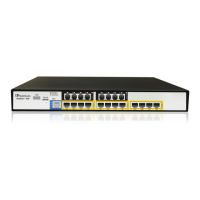User's Manual 346 Document #: LTRT-12809
Mediant 800 MSBR
Notes:
• You can configure up to two alternative routing rules in the Inbound IP
Routing table.
• If a Trunk is disconnected or not synchronized, the device issues itself
the internal Cause Code No. 27. This cause code is mapped (by default)
to SIP 502.
• The default release cause is described in the Q.931 notation and is
translated to corresponding SIP 40x or 50x values (e.g., Cause Code No.
3 to SIP 404, and Cause Code No. 34 to SIP 503).
• For analog interfaces: For information on mapping PSTN release causes
to SIP responses, see PSTN Release Cause to SIP Response Mapping
on page 324.
• For mapping SIP-to-Q.931 and Q.931-to-SIP release causes, see
Configuring Release Cause Mapping on page 319.
• For configuring IP-to-Tel routing rules in the Inbound IP Routing table,
see 'Configuring Inbound IP Routing Table' on page 336.
• The Reasons for Alternative Routing IP to Tel table can also be
configured using the table ini file parameter, AltRouteCauseIP2Tel or CLI
command, configure voip/gw routing alt-route-cause-ip2tel.
26.6.2 Alternative Routing to an IP Destination upon a Busy Trunk
You can configure the device to forward (i.e., call redirection) IP-to-Tel calls to an
alternative IP destination using SIP 3xx responses. This can be done upon the following
scenarios:
For digital interfaces: Trunk Group has no free channels (i.e., “busy”).
For analog interfaces: Unavailable FXS / FXO Trunk Group. This feature can be used,
for example, to forward the call to another FXS / FXO device.
This feature is configured per Trunk Group and is configured in the Forward on Busy Trunk
Destination table, as described in this section.
The alternative destination can be defined as a host name or as a SIP Request-URI user
name and host part (i.e., user@host). For example, the below configuration forwards IP-to-
Tel calls to destination user “112” at host IP address 10.13.4.12, port 5060, using transport
protocol TCP, if Trunk Group ID 2 is unavailable:
ForwardOnBusyTrunkDest 1 = 2, 112@10.13.4.12:5060;transport=tcp;
When configured with user@host, the original destination number is replaced by the user
part.
The device forwards calls using this table only if no alternative IP-to-Tel routing rule has
been configured in the Inbound IP Routing table or alternative routing fails and one of the
following reasons included in the SIP Diversion header of 3xx messages exists:
For digital interfaces: “out-of-service” - all trunks are unavailable/disconnected
"unavailable":
• For digital interfaces: All trunks are busy or unavailable
• For analog interfaces: All FXS / FXO lines pertaining to a Trunk Group are busy
or unavailable
Note: You can also configure the Forward on Busy Trunk Destination table using
the table ini file parameter, ForwardOnBusyTrunkDest
configure voip/gw routing fwd-on-bsy-trk-dst.

